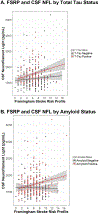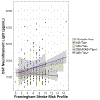Adverse Vascular Risk Relates to Cerebrospinal Fluid Biomarker Evidence of Axonal Injury in the Presence of Alzheimer's Disease Pathology
- PMID: 31381510
- PMCID: PMC6877290
- DOI: 10.3233/JAD-190077
Adverse Vascular Risk Relates to Cerebrospinal Fluid Biomarker Evidence of Axonal Injury in the Presence of Alzheimer's Disease Pathology
Abstract
Background: Vascular risk factors promote cerebral small vessel disease and neuropathological changes, particularly in white matter where large-caliber axons are located. How Alzheimer's disease pathology influences the brain's vulnerability in this regard is not well understood.
Objective: Systemic vascular risk was assessed in relation to cerebrospinal fluid concentrations of neurofilament light, a biomarker of large-caliber axonal injury, evaluating for interactions by clinical and protein markers of Alzheimer's disease.
Methods: Among Alzheimer's Disease Neuroimaging Initiative participants with normal cognition (n = 117), mild cognitive impairment (n = 190), and Alzheimer's disease (n = 95), linear regression related vascular risk (as measured by the modified Framingham Stroke Risk Profile) to neurofilament light, adjusting for age, sex, education, and cognitive diagnosis. Interactions were assessed by cognitive diagnosis, and by cerebrospinal fluid markers of Aβ42, hyperphosphorylated tau, and total tau.
Results: Vascular risk and neurofilament light were not related in the main effect model (p = 0.08). However, interactions emerged for total tau (p = 0.01) and hyperphosphorylated tau (p = 0.002) reflecting vascular risk becoming more associated with cerebrospinal fluid neurofilament light in the context of greater concentrations of tau biomarkers. An interaction also emerged for the Alzheimer's disease biomarker profiles (p = 0.046) where in comparison to the referent 'normal' biomarker group, individuals with abnormal levels of both Aβ42 and total tau showed stronger associations between vascular risk and neurofilament light.
Conclusion: Older adults may be more vulnerable to axonal injury in response to higher vascular risk burdens in the context of concomitant Alzheimer's disease pathology.
Keywords: Alzheimer’s disease; cerebrovascular; neurodegeneration; neurofilament light; vascular risk.
Conflict of interest statement
CONFLICT OF INTEREST/DISCLOSURE STATEMENT
The authors have no conflict of interest to report.
Figures


Similar articles
-
Neurofilament light as a biomarker of axonal degeneration in patients with mild cognitive impairment and Alzheimer's disease.J Integr Neurosci. 2021 Dec 30;20(4):861-870. doi: 10.31083/j.jin2004088. J Integr Neurosci. 2021. PMID: 34997710
-
Cerebrospinal fluid biomarkers of neurodegeneration, synaptic dysfunction, and axonal injury relate to atrophy in structural brain regions specific to Alzheimer's disease.Alzheimers Dement. 2020 Jun;16(6):883-895. doi: 10.1002/alz.12087. Epub 2020 May 6. Alzheimers Dement. 2020. PMID: 32378327 Free PMC article.
-
Non-beta-amyloid/tau cerebrospinal fluid markers inform staging and progression in Alzheimer's disease.Alzheimers Res Ther. 2018 Sep 25;10(1):98. doi: 10.1186/s13195-018-0426-3. Alzheimers Res Ther. 2018. PMID: 30253800 Free PMC article.
-
Cerebrospinal Fluid Biomarkers in Idiopathic Normal Pressure Hydrocephalus versus Alzheimer's Disease and Subcortical Ischemic Vascular Disease: A Systematic Review.J Alzheimers Dis. 2019;68(1):267-279. doi: 10.3233/JAD-180816. J Alzheimers Dis. 2019. PMID: 30741681
-
Clinical validity of cerebrospinal fluid Aβ42, tau, and phospho-tau as biomarkers for Alzheimer's disease in the context of a structured 5-phase development framework.Neurobiol Aging. 2017 Apr;52:196-213. doi: 10.1016/j.neurobiolaging.2016.02.034. Neurobiol Aging. 2017. PMID: 28317649 Review.
Cited by
-
Elevated plasma neurofilament light predicts a faster rate of cognitive decline over 5 years in participants with objectively-defined subtle cognitive decline and MCI.Alzheimers Dement. 2021 Oct;17(10):1756-1762. doi: 10.1002/alz.12324. Epub 2021 Apr 15. Alzheimers Dement. 2021. PMID: 33860596 Free PMC article.
-
Vascular risk burden is a key player in the early progression of Alzheimer's disease.Neurobiol Aging. 2024 Apr;136:88-98. doi: 10.1016/j.neurobiolaging.2023.12.008. Epub 2024 Jan 10. Neurobiol Aging. 2024. PMID: 38335912 Free PMC article.
-
White Matter Hyperintensities Are No Major Confounder for Alzheimer's Disease Cerebrospinal Fluid Biomarkers.J Alzheimers Dis. 2021;79(1):163-175. doi: 10.3233/JAD-200496. J Alzheimers Dis. 2021. PMID: 33252070 Free PMC article.
-
White Matter Disease and Outcomes of Mechanical Thrombectomy for Acute Ischemic Stroke.AJNR Am J Neuroradiol. 2020 Apr;41(4):639-644. doi: 10.3174/ajnr.A6478. Epub 2020 Mar 12. AJNR Am J Neuroradiol. 2020. PMID: 32165366 Free PMC article.
-
Effect of Resveratrol Combined with Donepezil Hydrochloride on Inflammatory Factor Level and Cognitive Function Level of Patients with Alzheimer's Disease.J Healthc Eng. 2022 Mar 25;2022:9148650. doi: 10.1155/2022/9148650. eCollection 2022. J Healthc Eng. 2022. Retraction in: J Healthc Eng. 2023 Jan 25;2023:9834320. doi: 10.1155/2023/9834320. PMID: 35368930 Free PMC article. Retracted. Clinical Trial.
References
-
- Ahtiluoto S, Polvikoski T, Peltonen M, Solomon A, Tuomilehto J, Winblad B, Sulkava R, Kivipelto M (2010) Diabetes, Alzheimer disease, and vascular dementia: a population-based neuropathologic study. Neurology 75, 1195–1202. - PubMed
-
- Aggarwal NT, Bienias JL, Bennett DA, Wilson RS, Morris MC, Schneider JA, Shah RC, Evans DA (2006) The relation of cigarette smoking to incident Alzheimer’s disease in a biracial urban community population. Neuroepidemiology 26, 140–146. - PubMed
-
- Breteler MM, van Swieten JC, Bots ML, Grobbee DE, Claus JJ, van den Hout JH, van Harskamp F, Tanghe HL, de Jong PT, van Gijn J, et al. (1994) Cerebral white matter lesions, vascular risk factors, and cognitive function in a population-based study: the Rotterdam Study. Neurology 44, 1246–1252. - PubMed
Publication types
MeSH terms
Substances
Grants and funding
- UL1 TR000445/TR/NCATS NIH HHS/United States
- R01 AG056534/AG/NIA NIH HHS/United States
- U01 AG024904/AG/NIA NIH HHS/United States
- F32 AG058395/AG/NIA NIH HHS/United States
- R01 HL111516/HL/NHLBI NIH HHS/United States
- U54 HD083211/HD/NICHD NIH HHS/United States
- R01 AG059716/AG/NIA NIH HHS/United States
- K01 AG049164/AG/NIA NIH HHS/United States
- R01 NS100980/NS/NINDS NIH HHS/United States
- R01 AG034962/AG/NIA NIH HHS/United States
- K23 AG045966/AG/NIA NIH HHS/United States
- S10 OD023680/OD/NIH HHS/United States
- UL1 TR002243/TR/NCATS NIH HHS/United States
- K24 AG046373/AG/NIA NIH HHS/United States
LinkOut - more resources
Full Text Sources
Medical

